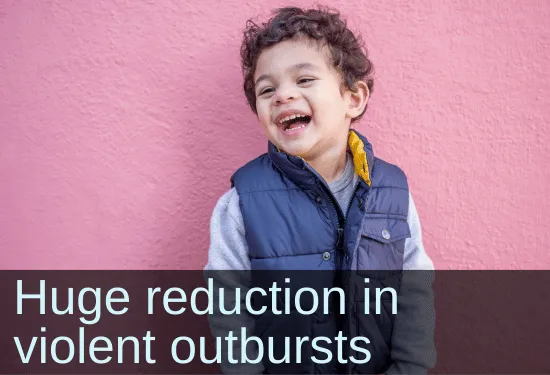Primitive Reflex Integration Case Studies
Reflex Integration Helps Boy with Oppositional Defiant Disorder
Preschooler quickly shows significant decrease in meltdowns
This young boy had at least one outburst every day, which could last up to an hour and typically involved throwing items, including chairs. His OT began providing rhythmic movements and reflex integration activities from the Brain and Sensory Foundations course, and by their third weekly session there were substantial improvements in his emotional regulation: His family reported that outbursts had decreased from daily to just once per week. After 8 weeks of these movements his meltdowns have reduced to 5 minutes in length, and he no longer throws things!
Submitted by Taylor Spaulding, OTR/L

| Before | After |
|---|---|
| Quick to anger, with daily physical and loud outbursts lasting 15-60 minutes | Outbursts down to once per week at most, lasting 5 minutes |
| Regularly knocked over and threw items, including chairs | No longer throwing things! |
| Had a hard time focusing | Keeping focus longer |
Rhett is a 5-year-old boy referred to occupational therapy due to oppositional defiant disorder. Caregiver reports concerns for behavior, defiant with instruction, very emotional. Mother reports this has been ongoing since 2-3 years old. He has physical outbursts of throwing things, knocking things off table, lifting chairs and throwing. He has not done this at the babysitter but does instigate other children there. The school reports difficulty with concentration but does not report these behaviors that occur at home. Mom reports her and Dad feel they are walking on egg shells around Rhett throughout the day in order to avoid an outburst. Rhett’s outbursts can last from 15 minutes to 60 minutes. He will throw, kick, slam things, etc. Mom reports he will eventually just stop and then go about his day but these can happen at least 1x/daily. Rhett’s primary behavior outbursts results in the evening when it is time to come in from outside.
After initial evaluation, it was determined Asymmetrical Tonic Neck Reflex (ATNR) and Spinal Galant reflex were present. Rhett and parents were taught rhythmic movements to initiate and provided with some functional activities for the reflexes [from the Brain and Sensory Foundations course]. By week 2, mom reports only 2 outbursts and that they are completing the rhythmic movements 1, 2a, and 2b daily. By week 3, mom reports only 1 outburst during the week versus daily. Rhett continued to complete rhythmic movements and was instructed on functional activities for ATNR and Spinal Galant at home.
In session 4, the 5-Step Balance process [from the Brain and Sensory Foundations course] was completed. Rhett’s goal: “I listen easily and quickly to come inside from playing outside when mom or dad tell me.” We also worded it “Would you like to feel more comfortable in your body when mom or dad tell you to come inside?” During the session, Rhett participated but had a hard time focusing. Upon returning for session 5, mom did not report any outbursts with coming in from outside over the past week, but did report an outburst with going to the babysitter.
I plan to implement the 5-step balance again with Rhett in visit number 6. I may change the goal slightly to help with having a more comfortable body during transitions. He normally struggles with coming in from outside at the end of the day, but I want to help his body throughout his day with different transitions. So, I’m thinking if we change the goal slightly, then the 5-Step Balance will address different transitions. I also plan to continue to work on the Spinal Galant and ATNR reflex with Rhett as he continues to have some challenges with these movements. I learned that implementing the activities throughout functional activities has made it easier for Rhett to participate and keep his focus longer as well.
Rhett has attended 5 follow-up sessions 1x/weekly for 30 minutes each. We are going to continue with this schedule for 5 more sessions with focus on the reflexes and emotional control strategies and then reassess from there. I’m excited to keep implementing these strategies with Rhett to help him at home.
Update [from an email to Sonia]: Now in week 8 of doing rhythmic movements and reflexes with him—both in sessions and at home—his mother reported that when he had an outburst it only lasted 5 minutes, and he didn't throw anything this time when his mom sat with him to help him regulate. He no longer has outbursts in his therapy sessions, and he is more aware of his body and feelings. For example, he was able to describe what happened last week when his mom told him to come inside. In the beginning, he was not able to recognize the outbursts/meltdowns.
(Edited, emphasis added)
*Disclaimer: The activities in the Brain and Sensory Foundations curriculum make use of the natural processes of neuroplasticity and development that are innately wired in the design of human beings to promote maturity and function. These activities appear to calm, organize, and mature the neuro-sensory-motor systems just as we see in the healthy development of human infants. Individual results may vary, and we do not claim to offer a diagnosis or cure for any specific condition or disorder. The Brain and Sensory Foundations activities appear to improve overall functioning resulting in measurable improvements for a range of conditions as demonstrated in over 1800 case studies from participants.

